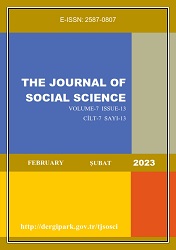İZMİR VE TİRE MÜZESİ TERRAKOTTA ÖRTÜLÜ KADINLAR FİGÜRİNLERİ
TERRACOTTA FIGURINES OF VEILED WOMEN FROM IZMIR AND TIRE MUSEUMS
Author(s): Derya ErolSubject(s): Gender Studies, Museology & Heritage Studies, Ancient World
Published by: Dicle Üniversitesi, Sivil Havacılık Yüksekokulu
Keywords: Chiton; Himation; Figurine; Terracotta; Tanagra;
Summary/Abstract: The veiled female figurines in the terracotta collections of the Izmir and Tire Museum, which were selected as the subject of the study, first appeared in the Ancient Greek world in the 4th century BC in the Tanagra settlement in the Boeiotia region. The production of these figurines, which provide important findings on the daily lives of ancient Greek women, was for religious purposes. They were left as offerings in the temples of goddesses associated with women such as Demeter or Artemis. They were also placed in large numbers in the tombs of Greek women. Since the Izmir and Tire Museum specimens were acquired to the Museum by purchase, their production areas or their relationship with the cults in the region cannot be determined exactly. In this context, the stylistic characteristics of the figurines were analysed and their similarities and differences with the types found in the important centres producing the terracotta veiled female figurine type were questioned and it was aimed to develop suggestions on this subject by examining which workshop they may be the products of. When the style characteristics of the figurines analysed in the study were examined, the following results were obtained. Among the figurines that are the subject of the study, the example with the inventory number 8607 in the Izmir Museum collection is dated to the 4th century BC with all the stylistic characteristics it shows and it is thought that it may be one of the figurines produced by Tanagra. Western Anatolia was one of the most important trade areas for the production of Tanagra workshops. Although example 3164 is dated to the 3rd century BC, it is suggested that it may have been produced in one of the workshops in Ionia due to its stylistic characteristics. Although the figure shows a very high quality workmanship, there is no clear indication as to which workshop in Ionia it could have been produced. In this context, it is suggested that it was produced by a workshop in Ionia with high quality workmanship. The terracotta veiled female figurines in the Tire Museum Collection were produced in the 3rd-2nd century BC and show all the characteristics of the Pergamon style. The Tire finds are figurines that may have been produced by a local workshop. It is thought that they may have been produced for lower income people for the grave or they may have been offered as offerings for the temples of Artemis and Demeter. The figurines of veiled women in the study area provide evidence for the continuation of a cult tradition in Western Anatolia during the Hellenistic period, which progressed in parallel with Continental Greece.
Journal: The Journal of Social Science
- Issue Year: 7/2023
- Issue No: 14
- Page Range: 236-263
- Page Count: 28
- Language: Turkish

